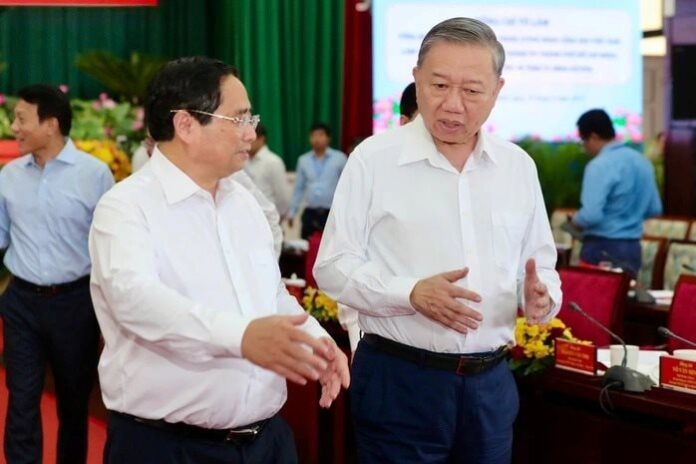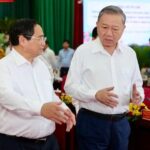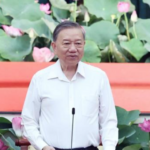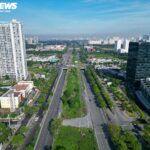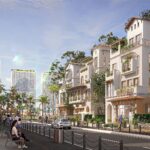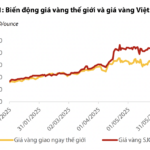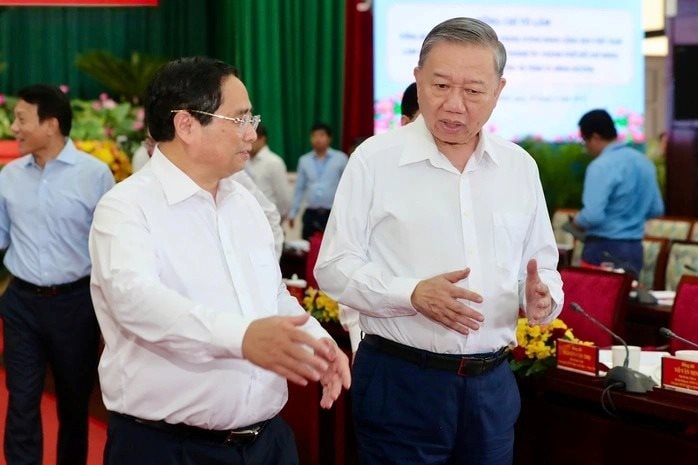
General Secretary To Lam and Prime Minister Pham Minh Chinh at the meeting. Photo: HT
The city that will become this “international metropolis” is the new Ho Chi Minh City.
On June 12, the National Assembly passed a resolution on the rearrangement of administrative units at the provincial level in 2025, reducing the number of provinces and cities in Vietnam from 63 to 34. This includes the merger of Ba Ria-Vung Tau province, Binh Duong province, and Ho Chi Minh City, to be named Ho Chi Minh City. The political and administrative center will be located in the current Ho Chi Minh City. Post-merger, the area of the new Ho Chi Minh City will be over 6,770 sq km, placing it among the largest urban areas in the region, comparable to Jakarta (7,600 sq km) and Bangkok (over 7,700 sq km), and larger than Shanghai (over 6,300 sq km). The new city will have a population of over 14 million people and 168 administrative units, including 113 wards, 54 communes, and 1 special district.
Vietnam’s Potential Mega-City of Finance, Industry, and Seaports
Today (June 18), in Ho Chi Minh City, a Central Working Delegation led by General Secretary To Lam had a working session with the Standing Committee of the Ho Chi Minh City Party Committee, Ba Ria-Vung Tau Provincial Party Committee, and Binh Duong Provincial Party Committee.
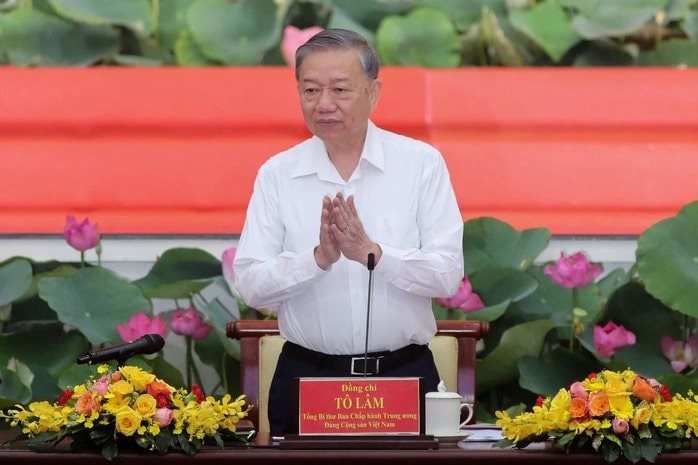
General Secretary speaking at the meeting. Photo: HT
At the meeting, the General Secretary emphasized that the integration of Ho Chi Minh City with Ba Ria-Vung Tau and Binh Duong marks a turning point in the history of urban development in Vietnam. This is a comprehensive reconfiguration of the development space, where the three most dynamic economic centers in the country converge to form a mega-city of finance, industry, and seaports.
According to the General Secretary, the new vision for the new Ho Chi Minh City is to become an “international metropolis” of Southeast Asia, a smart, green, and creative city, distinguished not only by its economic strength but also by its rich culture, arts, sports, entertainment, and modern, dynamic lifestyle. The new Ho Chi Minh City will be a regional-scale financial, commercial, logistics, high-tech industrial, and marine tourism center, oriented towards development based on digital technology, a green economy, environmental sustainability, a harmonious and open society, and a civilized city that crystallizes the advanced values of Asia and the world.
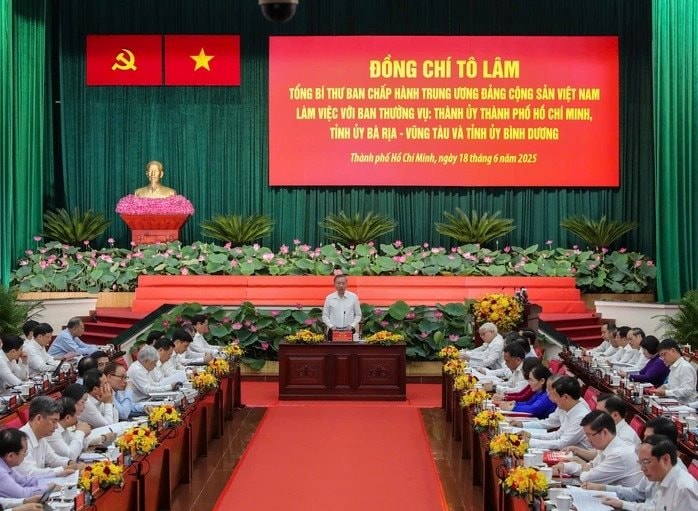
General Secretary requested that the new Ho Chi Minh City set specific goals for itself. Photo: HT
Ho Chi Minh City aims to be an attractive hub for talent, “creative individuals”, and entrepreneurs from Vietnam and abroad, as well as a favorable place for startups, innovation, and incubating new trends and advanced models. The General Secretary emphasized that the new Ho Chi Minh City should not only be the economic locomotive of the nation but also a modern city with global influence.
Therefore, the General Secretary requested that the new Ho Chi Minh City set specific goals for itself: By 2035-2045, where will its income rank? Where will it rank in Asia and globally in terms of innovation?
In addition, the General Secretary suggested that the new Ho Chi Minh City promote the construction of a science and technology ecosystem, innovation, and a strong private economy, not just with slogans but with specific actions. Moreover, the city should persist in the goal of comprehensively developing human resources, closely combining economic growth with social progress and equality, and quality of life. Not only a center of the economy, the new Ho Chi Minh City must become a livable place, where every citizen is ensured opportunities for development and is well taken care of in terms of health, education, living environment, and safety…
In 2024, Ho Chi Minh City ranked 2nd in the Digital Transformation Index, Binh Duong ranked 7th, and Ba Ria-Vung Tau ranked 2nd in administrative reform and 5th in PCI. In addition, Binh Duong is also in the Top 3 localities with the most effective implementation of free trade agreements and 5th in the Green Index.
Recently, the People’s Committees of Ho Chi Minh City, Binh Duong, and Ba Ria-Vung Tau had a working session to unify the plan for arranging the apparatus, departments, and public non-business units of the three localities to be ready to operate the model of local government at two levels from July 1.
“TT AVIO – Japanese Investment Fund: 30 Months of Interest-Free Support”
In a competitive real estate market where affordable housing is hard to come by, TT AVIO stands out not only for its convenient location and trend-setting amenities but also as one of the few projects that enable young people to achieve their dream of homeownership without compromising their financial future.
The Capital’s Housing Conundrum: Unraveling the Reasons Behind Hanoi’s Sky-High Property Prices, Doubling Ho Chi Minh City’s – Experts Reveal Areas with Opportunities in the Next Six Months
“Recent insights shared by Mr. Dinh Minh Tuan, Regional Director of Batdongsan.com.vn for Southern Vietnam, reveal an interesting trend. According to Mr. Tuan, investors are now channeling their funds into more affordable areas and biding their time for strategic opportunities in the upcoming periods. This shift in investment strategy showcases a prudent approach, given the current market dynamics and the potential for future growth in these underserved regions.”
The Skyway Link: Unveiling the Route Connecting Saigon’s Southern District and Long Thanh Airport
The construction of a two-tier, high-speed road will create a vital transport link between Tan Son Nhat and Long Thanh airports. This ambitious project will not only reduce travel time between the two airports but also revolutionize the transportation landscape in the region. With a seamless connection, passengers can look forward to a more efficient and convenient travel experience, boosting the potential for economic growth and development.

























